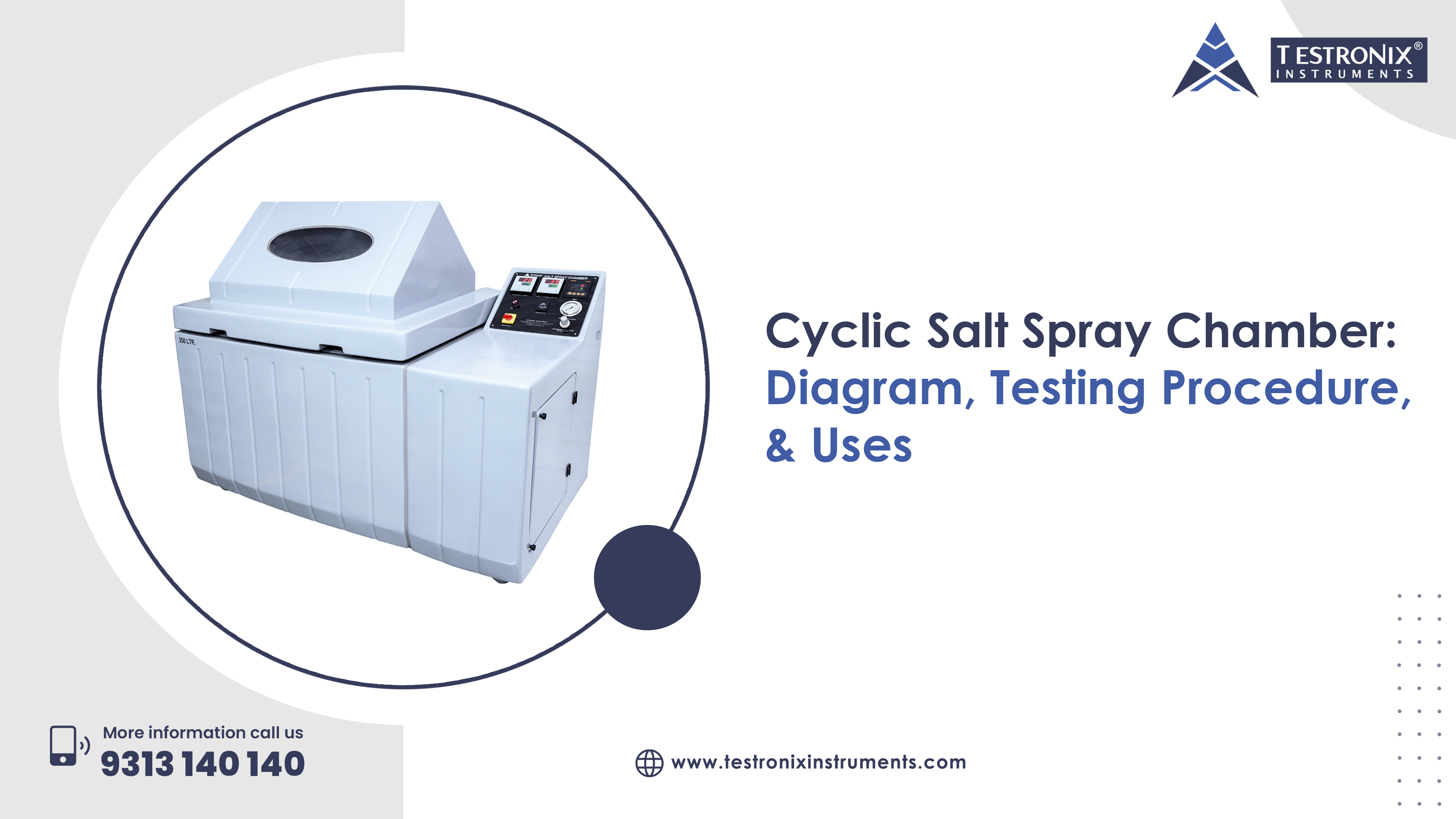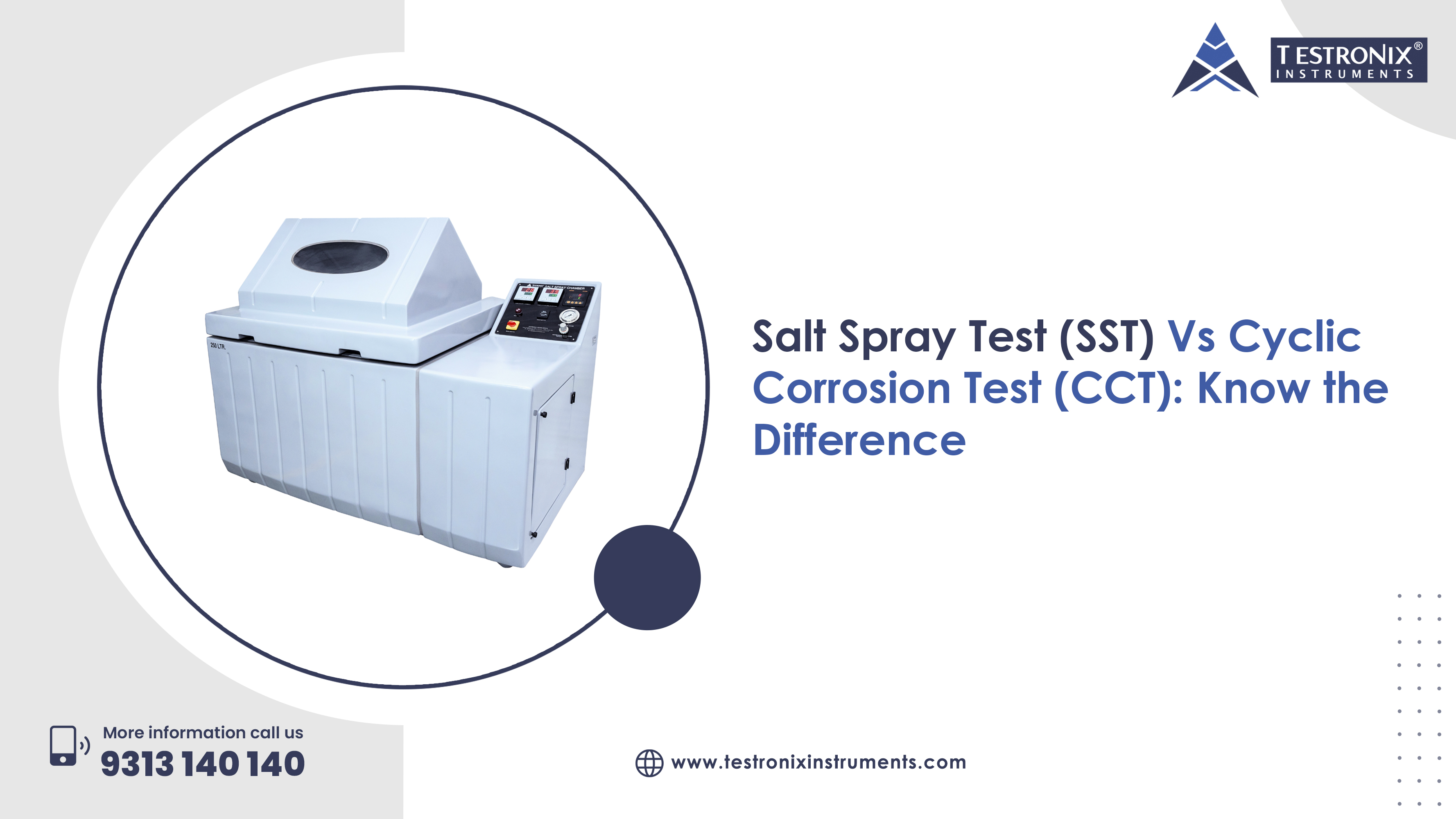Corrosion testing plays a vital role in determining the performance and reliability of materials in exposure to harsh environments. One of the most reliable and best-established methods of simulating natural corroding conditions is the cyclic salt spray test. Unlike the usual salt spray test, which provides a static condition, the cyclic salt spray chamber simulates natural weathering by varying between salt spray, humidity, drying, and occasionally temperature variation. This makes it an essential tool in manufacturing sectors such as automobile, aviation, metal finishing, and coatings, where product durability forms one of the most crucial quality measures.
What is Cyclic Salt Spray Test
The Cyclic Salt Spray Test is a standardized method to evaluate the corrosion resistance of materials, coatings, and surface finishes. It simulates harsh environmental conditions by exposing samples to alternating cycles of salt fog, humidity, and drying periods. This testing helps predict how well products will withstand corrosion over time, making it a critical assessment for industries such as automotive, aerospace, and manufacturing, where durability and longevity are essential.
This approach more accurately simulates the harsh and forceful conditions encountered in real service environments. By accelerating the natural process of corrosion, cyclic testing provides automotive, marine, aerospace, and construction industry manufacturers with valuable data to verify product performance, ensure compliance with global standards, and demonstrate overall durability and reliability.
What is Cyclic Salt Spray Test Chamber
A cyclic salt spray test chamber is a laboratory equipment that mimics real corrosive conditions through programmed salt fog, humidity, wetting, and drying cycles. Compared with conventional salt spray chambers, it yields accelerated, realistic corrosion testing, enabling automotive, aerospace, and metal finishing industries to validate material performance, improve coating robustness, and ensure compliance with international standards of quality.
Cyclic Salt Spray Chamber Diagram
A cyclic salt spray chamber diagram consists of the test chamber, salt solution tank, spray nozzles, air saturator, heater, humidity controller, and drainage unit. It illustrates how these components work together to simulate changing environmental conditions for corrosion testing. It helps visualize the internal layout and flow of operations within the chamber, offering insight into how each stage of the cyclic test is conducted.

-
Sealed Chamber: The central cover in which the testing takes place.
-
Specimen Racks: Supports within the chamber to hold the test specimens at a set angle.
-
Salt Solution Reservoir & Atomizer: A device to hold the salt solution and a nozzle that atomizes the solution into a fine mist (fog) onto the specimens.
-
Temperature Control System: Maintains and stabilizes the chamber temperature, which may be fixed or vary according to the test cycle.
-
Humidity Control System: Maintains and adds humidity, typically to levels greater than 98% relative humidity (RH) for a period in the cycle.
-
Drying/Dehumidification Unit: Equipment for removing moisture, defining the dry phases of the cycle.
-
Exhaust/Ventilation System: Supplies air exchange and removal of moisture and salt fog from the chamber.
-
Control Panel: Programming and monitoring interface for test cycles, temperatures, humidity, and salt fog rates.
Cyclic Salt Spray Chamber Working Principle
The working principle of a cyclic salt spray chamber is based on alternating different environmental conditions such as salt fog, humidity, drying, and condensation, to simulate natural weathering and accelerate corrosion. The chamber automatically cycles through these conditions in a controlled sequence, allowing materials to experience varying stresses similar to real-world environments.
How Salt Spray Test is Done? Working Procedure
Salt spray testing involves key steps: specimen preparation, preparing the salt solution, setting up the salt spray chamber, placing the samples, starting the test, monitoring the process, completing the testing, and inspecting the samples and evaluating the results.
Prepare the Specimen
Dry and clean the test samples to remove contaminants like oil, dust, or prints. Proper surface preparation produces correct results by preventing outside contaminants from affecting corrosion performance.
Prepare the Salt Solution
Mix the standard sodium chloride solution, typically 5% by weight, with deionized water. Adjust the pH (usually between 6.5 and 7.2) to meet testing specifications. The solution must be properly filtered and without impurities in order to produce reproducible results throughout the salt spray exposure.
Prepare the Salt Spray Chamber
Condition the chamber conditions to the reference test, for example, ASTM B117 or ISO 9227. Set the temperature, typically to 35°C, and ensure that atomizing nozzles and air pressure gear are functioning correctly before starting the test cycle to provide stable spraying.
Position the Samples
Position the specimens on sloping shelves in the chamber in such a way that no salt solution forms on the surface. Leave sufficient sample spacing to allow fog exposure and air flow to be uniform and so that all sides of the specimens are exposed to the corrosive environment evenly during the test.
Start the Test
The system contains controlled temperature, humidity, and spray distribution during the test period. The test may be executed continuously or under some cyclic conditions as dictated by the selected standard or customer-specific needs for consistent results.
Monitor the Test
Check temperature, fog collection rate, pH level, and air pressure periodically to ensure standards. Record data as per the test specification. Monitoring ensures environmental conditions are consistent to prevent deviations from influencing test validity or yielding defective corrosion results.
Examine Samples
After the given exposure time, shut down the chamber and take out the specimens slowly. Wash them slowly to remove any remaining salt residue without damaging the corrosion products. Dry the samples completely before looking at them visually in detail for signs of corrosion or defects.
Analyze the Results
Inspect the specimens as per the acceptance criteria of the standard, looking for the development of rust, blistering, pitting, or deterioration of the coating. Record the percentage of the affected area and compare results with performance specifications to determine if the material or coating is acceptable for industry durability standards.
Uses of Cyclic Salt Spray Test Machine
A cyclic salt spray test machine is industrially used in multiple industries to mimic natural, fluctuating corrosive environments and predict product performance. It provides an improved simulation of long-term service conditions while switching between salt fog, humidity, and drying cycles.
Automotive Component Testing
For the automotive industry, cyclic salt spray chambers assess the corrosion resistance of automotive parts like body panels, fasteners, underbody coatings, and exhaust systems. The test replicates exposure of the vehicle to road salt, water, and temperature change in real usage conditions, enabling manufacturers to ensure long-term performance.
Paints and Coatings Evaluation
Paint, powder coatings, and plating are subjected to cyclic chambers to determine if they can withstand varying environmental conditions. It ensures coatings provide lasting protection from blisters, rust, and peeling. It enables paint manufacturers to validate product quality, distinguish between formulations.
Marine Equipment Testing
Seawater immersion, water sprays, and drying conditions regularly immerse marine parts. Cyclic salt spray testing is used to test materials like ship fittings, offshore machines, and marine parts. The treatment avoids premature failure, improves corrosion resistance, and ensures safety in corrosive marine environments.
Metal Surface Treatment Verification
Surface-treated materials such as galvanized steel, anodized aluminum, and electroplated parts are put through a test for their corrosion protection effectiveness. The cyclic chamber helps to pinpoint weak spots in coatings, plating defects, or thinness, so manufacturers can revise their surface finishing procedures to provide better protection to end-users.
Quality Control and Research
Cyclic salt spray chambers are vital for R&D and production quality assurance. They allow manufacturers to benchmark materials, develop better protective coatings, and optimize processes before market launch. This reduces field failures, facilitates product innovation, and ensures industry-specific durability compliance in the automotive, construction, and aerospace sectors.
Through the simulation of actual atmospheric corrosion conditions, it becomes possible to speed up product development, quality, and conformance to global standards. Testronix Instruments, a global leader in manufacturing advanced testing instruments, offers high-performance cyclic salt spray chambers that enable industries to achieve reliable, repeatable, and standard-compliant corrosion testing.



